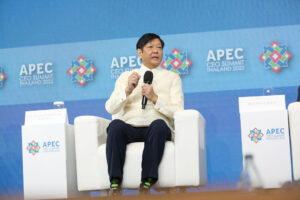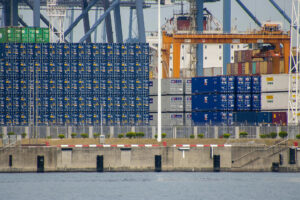High inflation, rate hikes drag financial markets; analysts wary of global recession fears

By Bernadette Therese M. Gadon, Researcher
THE CENTRAL BANK’S monetary policy tightening to combat stubbornly high commodity prices dragged the domestic financial markets last year.
But as inflation continues to rage on this year, analysts are wary of its effect on the overall economic output as they brace for potential global recession.
The Philippine Stock Exchange index (PSEi) closed the last quarter with 6,566.39, up by 14.4% from the 5,741.07 during the third quarter. However, the index was lower by 7.8% from 7,122.63 in the October-to-December 2021 period.
Demand for Treasury bills auctions saw a total subscription amounting to P220.6 billion with only P51.2 billion total offered amount in the fourth quarter.
The oversubscription amount of P169.4 billion was lower than the P267.2 billion in the third quarter.
Meanwhile, demand for Treasury bonds eased to P572.9 billion, lower than the P1.2 trillion in the third quarter. However, this was higher than the aggregate offered amount of P259.3 billion in final three months of 2021.
At the secondary bond market, domestic yields surged by 111.4 basis points (bps) on average, based on the PHP Bloomberg Valuation Service Reference Rates published on the Philippine Dealing System’s website.
On a year-on-year basis, yields also grew by 217.9 bps.
As the year closed, the peso settled within the P55 range as it closed at P55.7550 on the last trading day of December, according to the Bankers’ Association of the Philippines. This was P4.76 weaker than the P51 finish on Dec. 31, 2021.
According to the Bangko Sentral ng Pilipinas (BSP) data, the peso averaged P55.6839 in December, recovering from P57.4338 in the previous quarter. However, this was still weaker compared with the P50.2478 average in the same quarter a year ago.
On an end-of-period basis, the local unit finished at P56.1200 in December, weaker than the P50.7740 in December 2021.
Inflationary pressures that prompted tighter monetary policies were what affected the local financial market last year, analysts said.
Early last year, inflation spiked on higher global oil prices due to the outbreak of Russia-Ukraine war in February, which started a domino effect on commodities as transport fares and food commodities rose along with it.
The BSP said in an e-mail that the National Government implemented non-monetary measures through fuel subsidies, vouchers to the agriculture sector, lowering import duties, easing non-tariff barriers, and supporting farm productivity to address domestic inflation.
However, BSP tightened monetary policy settings by a total of 350 bps in 2022 when inflation continued to climb despite the government’s efforts.
“The monetary tightening was anchored on the BSP’s assessment that domestic demand was firmly on its way to full recovery and would be resilient enough amid interest rate increases,” the central bank said in an e-mail.
“While the BSP continually raised rates to curb inflation, this proved to be insufficient in mitigating the internal and external forces that fueled high inflation rates last year,” Union Bank of the Philippines (UnionBank) Chief Economist Ruben Carlo O. Asuncion said in an e-mail.
“Much of inflation were supply-driven and that [the Philippines] is a net importer of oil. Thus, this makes the country very vulnerable to oil and food supply shocks,” Mr. Asuncion said.
The fourth quarter was more affected as the continued supply-chain disruptions and increased demand on a fully reopened economy led to the devaluation of the peso, he added.
In a separate e-mail note, HSBC Global Research ASEAN Economist Aris Dacanay said that in the last quarter, food became the main culprit as the consumer price index of the food basket rose to double-digit levels in the last two months of 2022 due to typhoons that affected the agriculture sector back in October, as well as importation of food.
“Nonetheless, despite the squeeze in household budgets, GDP (gross domestic product) of the Philippines grew remarkably, growing above expectations in the [third and fourth] quarter of 2022. Despite higher interest rates, bank lending continued to grow, driven by the economy’s strong post-pandemic recovery after the economy’s initial ‘reopening’ and when face-to-face classes resumed,” Mr. Dacanay added.
The country’s GDP grew by 7.2% in the last quarter putting the full-year growth to 7.6%.
This was the highest pace in 46 years or since the 8.8% in 1976.
ING Bank N.V. Manila Branch Senior Economist Nicholas Antonio T. Mapa said the high interest rate environment slowed the momentum in the last quarter of the year.
“Revenge spending was at the heart of the recent growth run and we have seen how momentum appears to be slowing. High inflation may be sapping spending power and discouraging additional spending… Softer capital formation robs us of potential output down the line and points to slowing growth in the medium term,” Mr. Mapa said in an e-mail.
PHL SAFE FROM RECESSION?With inflation climbing up globally and tighter monetary policies put in place to combat it, talks of recession in other countries made the rounds as the year ended. While the latest data showed recession is not likely in the Philippines, other countries’ somber economic output sparked fears that a global recession may take down the Philippines as well.
The central bank expects the financial market to perform positively this year amid expectations of robust domestic economic growth and lower domestic inflation. However, it warns of volatility in the market as “downside risks from global monetary policy tightening in advanced and domestic economies remain.”
Analysts said that the Philippines is not likely to go into recession as it is not an export-dependent country, and the economy mainly relies on domestic consumption for growth.
However, they are projecting slower growth this year as demand momentum and base effects dissipate.
“Downturns in advanced economies, possibly recessions, will also weaken exports demand, but resilient domestic demand will help temper a slowdown in external trade,” Domini S. Velasquez, chief economist at China Banking Corp. (China Bank), said in an e-mail note.
“The recent Chinese reopening may also provide a much-needed boost in the face of looming recessions in advanced economies,” she said.
“We also need to look out for substantial downward earnings revisions from US corporates through the year given prospects of a recession in developed markets. This could affect over-all risk appetite among global investors, and lead to a drying-up of fund flows in other markets,” Rastine Mackie D. Mercado, research director at China Bank Securities Corp., said.
UnionBank’s Mr. Asuncion said that the market should always be prepared for any economic downturn, giving indicators that signal a recession is coming such as rising unemployment rates, declining GDP growth, higher interest rates, and overall decline in consumer confidence.
“During economic downturns, it is best for individuals to have an emergency fund, minimize debt, and maintain a well-diversified portfolio,” Mr. Asuncion said.
WHAT TO WATCH OUT FORIn the meantime, analysts are mainly taking cues from the central bank’s monetary policy and growth outlook to brace for a potential global recession.
The central bank said that future monetary policy decisions will be primarily guided by data on domestic inflation and growth outlook.
The BSP raised interest rates again by 50 bps on Feb. 16, bringing policy rates to a 16-year high of 6%.
In addition, the central bank also revised its inflation forecast this year to reach 6.1% from 4.5%, breaching the 2%-4% target.
“The BSP remains focused on bringing inflation back to the [2%-4% target] and remains prepared to undertake all necessary actions to achieve its inflation mandate,” BSP said.
“Aside from interest rate increases, the BSP provided forward guidance through monetary policy communication on the inflation outlook, the pace of interest rate increases, and the role of FX (foreign exchange) market participation in response to external spillovers to the FX market,” the central bank added.
UnionBank’s Mr. Asuncion said to look for signs of disinflation this year as this will slow the rate hikes of the country’s central bank. He also advised financial markets to pay attention to changes in energy prices seeing what happened last year impacted production and cost of commodities.
HSBC’s Mr. Dacanay said that food policies should be monitored as it remains to be the catalyst for this year’s inflation outlook.
China Bank’s Ms. Velasquez said that advanced economies will see pronounced downturns this year, with recessionary risks in major economies such as the United Kingdom and the European Union.
“Markets still currently expect the US Fed to cut rates by end of the year despite continued pronouncements from policy makers that rate cuts this year are not being considered at this time. This dissonance could spur volatility through the year and weigh on risk appetite for risky assets,” China Bank Securities’ Mr. Mercado said.
Likewise, domestic inflation is expected to gradually trend downward but remain elevated for most of the year, Ms. Velasquez said, adding that inflation rate may return below 4% by end of the year.
“Possible early reopening in China could be positive for global growth outlook but might also lift global commodity prices (e.g. oil),” Ms. Velasquez said.
With these factors to watch out for, how will the local financial market perform this year?
FOREIGN EXCHANGE (FX) MARKETBSP: The country’s overall balance of payments (BoP) will be the dominant force in determining the future path of the peso-dollar exchange rate. While the BoP is expected to be in deficit in 2023, the reopening of China could pave the way for a rebound in global demand for semiconductors, which could help support FX inflows to the Philippines.
Moreover, structural FX flows coming from the business process outsourcing (BPO) sector, overseas Filipinos, and foreign direct investments (FDI) will continue to provide support to the peso. Likewise, the further easing of foreign entry and mobility restrictions, coupled with the renewed influx of tourists, is expected to generate FX receipts in the form of increased tourism activities. The ample gross international reserves (GIR) also provide a level of comfort in the peso amid the current challenging global environment.
UnionBank’s Mr. Asuncion: Given the expectations of a weaker dollar, we expect the USDPHP to trade around the 53-54 levels in [the first quarter] and continue to trade around the 52-54 levels throughout the year. However, if the dollar shows for some reason, we may see the USDPHP trade at 54-55 levels.
China Bank’s Ms. Velasquez: The latest dot plot projects the Fed funds rate to reach 5.1% in 2023 before being cut to 4.1% in 2024. However, markets are still pricing in lower rate hikes and hence, we think the USD might have reached its peak already.
Emerging market currencies will likely strengthen this year and the next as these countries lift global GDP, especially with China’s reopening. That is, risk on sentiment will likely drive emerging markets’ currencies, including the PHP higher.
Our base scenario is a soft landing for the US economy in 2023. However, in the off chance of a deeper-than-expected downturn or hard landing in the US, the USD may strengthen given its status as a safe-haven currency.
ING’s Mr. Mapa: 2023 was expected to be a year wherein the strong dollar theme faded. Surprisingly resilient US jobs data likely pushes back the Fed pivot for now so Asian currencies likely to give up some of the early gains in the near term. But when the Fed does conduct its pivot, we expect the local unit to track the regional rally although PHP should likely underperform due to the chronic trade deficits of the Philippines.
EQUITIES MARKETBSP: The strong economic growth outturn for 2022 and the positive growth outlook for 2023 could support investor confidence toward the local equities market. Meanwhile, the anticipated decline in domestic inflation in the second half of 2023, improvement in labor market conditions, and the BSP’s firm commitment to take decisive monetary policy actions to bring inflation back to a target-consistent path are expected to sustain household spending, thereby providing further support to corporate earnings.
Furthermore, providing support to positive market sentiment are the dissipating concerns on global recession given the higher-than-expected 2022 GDP growth of major economies, particularly the US and the Eurozone, and optimistic global growth prospects amid the easing of COVID-19 restrictions in China.
On the other hand, risks to the macroeconomic outlook remain, which could adversely impact the demand for Philippine stocks. These risks include the following: inflation becoming further entrenched should there be unforeseen supply shocks, pivot in global growth trajectory amid lingering health risk and deepening property market crisis in China, and escalation in the Russia-Ukraine conflict that could disrupt the global supply chain and raise food and fuel prices further.
Mr. Asuncion: Given the continued search for disinflation and recession expectations, we expect the PSEi to trade lower in [the first quarter 2023] within the 6,600-6,900 range and maintain a downward trajectory in [the second and third quarter], before it can recover on the 7,200-7,600 range in [the fourth quarter].
China Bank Securities’ Mr. Mercado: [First quarter 2023] could offer continuing reprieve from the weakness experienced for most of last year. However, investors will be watching closely at economic data and earnings performance for the quarter (which is due out in May), and this will likely prompt price action for the succeeding months.
Changes in: (1) the outlook for monetary policy, as well as their main drivers (e.g. inflation), and (2) geopolitical landscape (e.g. escalation in Russia-Ukraine), could drive volatility in markets.
FIXED-INCOME MARKETBSP: Domestic yields will continue to be influenced by monetary policy actions of the BSP, with a downward bias amid expectations of domestic inflation declining toward the government’s target range in the second half of the year. In the near term, anticipated moderate policy rate hikes and looming risks of a global recession continue to drive investors toward safe assets, such as government securities. This is already manifesting in the high subscription rates consistently seen in the weekly Bureau of the Treasury (BTr) auctions, with market preference leaning toward shorter-dated debt securities.
Mr. Asuncion: If the BSP continues to match the US Fed with its smaller rate hikes, we expect short-term bonds to continue to be profitable and stable in [the first quarter]. Towards the end of the year when rate hike cycles are expected to end, long-term bonds will be more attractive.
Ms. Velasquez: Interest rates are on the verge of peaking for the short end, at least. Two more rate hikes from the BSP should keep short-term interest rates quite elevated. For long ends, interest rates might have peaked already, with the BSP’s rate hikes already priced in.
Mr. Mapa: Long-end yields to likely be pressured higher by persistent elevated inflation. Short-end yields to take their cue from the BSP, whose policy post July will depend largely on who will be replacing Governor [Felipe M.] Medalla.




